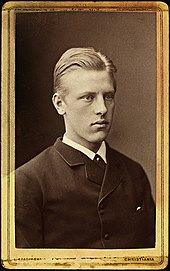Fridtjof Nansen
Fridtjof Nansen | |
|---|---|
 | |
| Born | 10 October 1861 Store Frøen,Christiania(now called Oslo),Norway |
| Died | 13 May 1930(aged 68) |
| Cause of death | Heart attack |
| Education | The Royal Frederick University |
| Occupation(s) | Scientist, explorer, humanitarian |
| Spouse(s) | Eva Sars(died 1 December 1907) Sigrun Munthe |
| Children | 2 daughters, 3 sons |
| Parent(s) | Baldur Nansen and Adelaide (née Wedel-Jarlsberg) Nansen |
| Awards | Nobel Peace Prize(1922) Kongelige Norske St. Olavs Orden Order of the Dannebrog National Order of the Legion of Honor Order of St. Stanislaus Cullum Geographical Medal(1897) Vega Medal(1889) Constantine Medal(1907) |
| Signature | |
Fridtjof Wedel-Jarlsberg Nansen(10 October 1861 – 13 May 1930) was aNorwegianexplorer,historian,scientist,diplomat,humanitarianand aNobel Peace Prizewinner. From 1922 to 1927, Nansen was theLeague of Nations High Commissioner for Refugees.
Career
[change|change source]In his youth a championskierandice skater,he led the team that made the first crossing of theGreenlandinterior in 1888, and won international fame after reaching a record northernlatitudeof 86°14′ during hisNorth Pole expeditionof 1893–96. Although heretiredfrom exploration after his return to Norway, his techniques of polar travel and hisinnovationsin equipment and clothing influenced laterArcticandAntarcticexpeditions.

Nansen studiedzoologyat theRoyal Frederick University,and later worked as acuratorat theBergenMuseum where his research on thecentral nervous systemoflower marine creaturesearned him adoctorateand helped establish modern theories ofneurology.After 1896 his main scientific interest switched tooceanography;in the course of his research he made many scientific cruises, mainly in theNorth Atlantic,and contributed to the development of modern oceanographic equipment. As one of his country's leading citizens, in 1905 Nansen spoke out for the ending of Norway's union withSweden,and was instrumental in persuadingPrince Charles of Denmarkto accept the throne of the newly independent Norway. Between 1906 and 1908 he served as the Norwegian representative inLondon,where he helped negotiate the Integrity Treaty that guaranteed Norway's independent status.
In the final decade of his life Nansen devoted himself primarily to theLeague of Nations,following his appointment in 1921 as the League's High Commissioner for Refugees. In 1922 he was awarded the Nobel Peace Prize for his work on behalf of the displaced victims of theFirst World Warand related conflicts. Among the initiatives he introduced was the "Nansen passport"for stateless persons, a certificate recognised by more than 50 countries.
Death and honors
[change|change source]He worked on behalf of refugees until his sudden death from aheart attackin 1930, after which the League established the Nansen International Office for Refugees to ensure that his work continued. This office received the Nobel Peace Prize for 1938. Nansen was honoured by many nations, and his name is commemorated in numerous geographical features, particularly in thepolar regions.
Further reading
[change|change source]- Abrams, Irwin (2001).The Nobel Peace Prize and the Lauretes: an illustrated biographical history 1901–2001.Nantucket MA: Watson Publishing International.ISBN9780881353884.
- Amundsen, Roald(1912).The South Pole, Vol. II.London: John Murray.
- Berton, Pierre (1988).The Arctic Grail.New York: Viking Penguin.
- Brøgger, Waldemar Christofer and Rolfsen, Nordahl (translated by William Archer (1896)).Fridtiof Nansen 1861–1893.New York. Longmans Green & Co.
- Fleming, Fergus (2002).Ninety Degrees North.London: Granta Publications.
- Gibney, Matthew J.; Harrison, Randall (2005).Immigration and Asylum from 1900 to the Present: Volume 1.Santa Barbara, California: ABC-CLIO.[permanent dead link]
- Huntford, Roland (2001).Nansen.London: Abacus.(First published in 1997 by Gerald Duckworth)
- Jackson, Frederick (1935).The Lure of Unknown Lands.London: G. Bell and Sons.
- Nansen, Fridtjof (tr. H.M. Gepp) (1890).The First Crossing of Greenland.London: Longmans, Green.ISBN9781108031097.
- Nansen, Fridtjof (1897).Farthest North, Volumes I and II.London: Archibald Constable & Co.ISBN9781602392373.also available onProject Gutenberg
- Pollock, Frederick (2003).The League of Nations.Clark, New Jersey: The Lawbook Exchange Ltd.ISBN9781584772477.
- Reynolds, E.E. (1949).Nansen.Harmondsworth (UK): Penguin Books.
- Scott, J.M. (1971).Fridtjof Nansen.Sheridan, Oregon: Heron Books.
- Hestmark, Geir (1991): Fridtjof Nansen and the Geology of the Arctic. Earth Sciences History 12: 168-212.
- Hestmark, G. (1995): Fridtjof Nansen and the Spirit of Northern Wilderness. In: Vance G. Martin & Nicholas Tyler: Arctic Wilderness - The 5th World Wilderness Congress. North American Press, Golden, Colorado. pp. 113–117.
- Hestmark, Geir (1999). Vitenskap og nasjon - Waldemar Christopher Brøgger 1851-1905. Oslo, Aschehoug & Co. (W. Nygaard). 890 pp.
Other websites
[change|change source]- Works by or about Fridtjof NansenatInternet Archive(scanned books original editions color illustrated)
